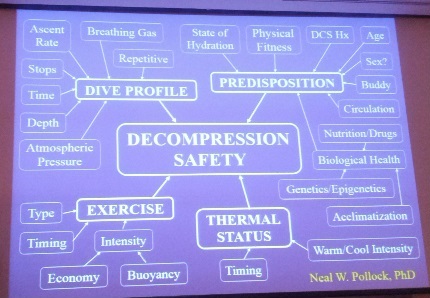So in order to make your point, you use a photo from an animal study, where the ascent and ceiling violations were so gross, that it caused death, and allowed for a dissection of tissue that showed honking great bubbles..
No, I used the photo in order to demonstrate a
part of my point, which is that the propensity to form bubbles in tissue capillaries (VGE) and bubbles in tissues are not unlinked as you are trying to imply.
And now you want us to think (scare), that humans suffer this every day, on a grade 4 VGE, but not a grade 2 VGE dive ???? i.e. a 10 minute difference in deco time. Hmm... sounds like BS Simon.
I'm not quite sure what you are trying to say here Ross.
Simon, Find some literature that actually supports your extra vascular microbubble growth == intra vascular VGE growth in normal everyday diving?? Because almost every diver has VGE, your theory therefore implies that every diver suffers this breakout condition. It doesn't ring true Simon.
Read my post Ross. Bubbles breaking into capillaries is only one "possible" way in which a propensity for tissue bubble formation and VGE
MUST be linked. The other more important and irrefutable issue is that the capillaries acquire their supersaturated gas from the tissues. Thus, what is going on in the tissue capillaries is a direct reflection of what is going on the tissues. If a diver is forming greater numbers of VGE then there must be a concomitant propensity for greater numbers of bubbles to be forming in tissues. David has alluded to these same processes independently in his post 1006 above.
I don't think anyone is going to be convinced by this gross exaggeration and trickery you are playing at.
I guess I've been able to "trick and exaggerate" my way around my academic colleagues who asked me to write the following textbook chapters / sections on decompression sickness pathophysiology which contain all the things I am saying here.
FRANCIS TJR, MITCHELL SJ. The pathophysiology of decompression sickness. In: Brubakk AO, Neuman TS (Eds).
Bennett and Elliott’s Physiology and Medicine of Diving (5th ed). London, Harcourt Publishers, 530-556, 2003
FRANCIS TJR, MITCHELL SJ. Pathophysiology of decompression sickness. In: Bove AA (Ed).
Bove and Davis’ Diving Medicine (4th ed). London, Saunders Publishing, 165-184, 2004
BENNETT MH, MITCHELL SJ. Hyperbaric and Diving Medicine. In: Longo DL, Fauci AS, Kasper DL, Hauser SL, Jameson JL, Loscalzo J (eds).
Harrison’s Principles of Internal Medicine (19th ed). McGraw – Hill, Chapt e477: 2015
MITCHELL SJ. Decompression sickness - Pathophysiology. In: EDMONDS C, BENNETT MH, LIPPMANN J, MITCHELL SJ (eds).
Diving and Subaquatic Medicine (5th ed). Florida, USA, Taylor and Francis, 125-140, 2015
And while we are at it, explain how VGE can be reduced by a good pre-dive shake, or a nice warm bath, or how a Breath hold diver can make grade 4 bubbles.. etc. etc..
David has dealt with your misinterpretation or (?deliberate) misrepresentation of the breath hold paper. Nevertheless, although there is a lot of potentially interesting discussion that could be framed around these questions, I don't quite see what this has to do with the issue we are debating.
I did a follow up with him the next day, without your interference.... makes a world of difference.
Yes, and....??






